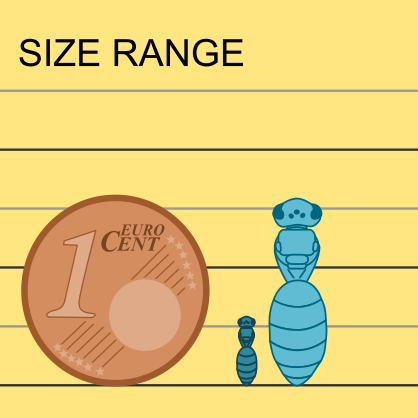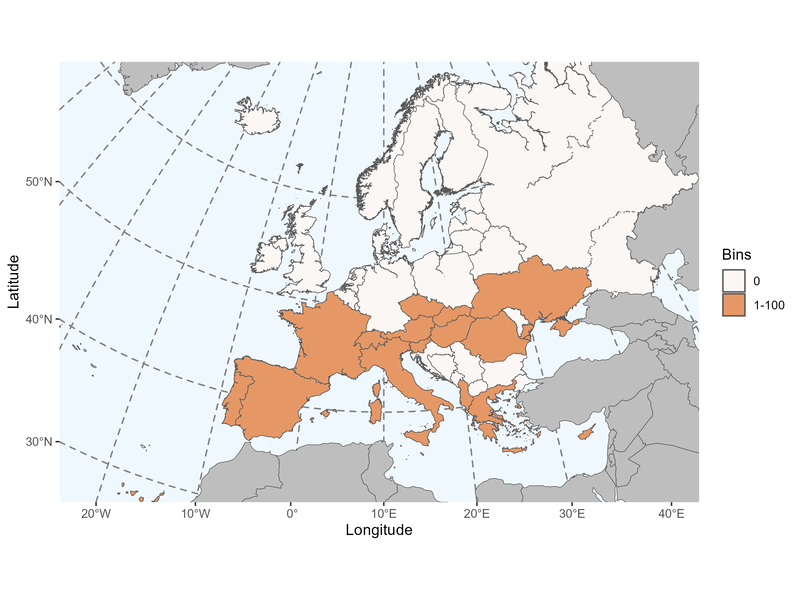Authors: Lepeletier and Serville, 1825
|
Type species: Trachusa cincta Jurine, 1807, monobasic.
Synonyms: Hoplopasites Ashmead, 1898; Chrysopheon Titus, 1901. |
Clade: Anthophila
Family: Megachilidae SubF: Megachilinae Tribe: Dioxyini |
|
Distinctive traits
|
Pictures of distinctive traits.
(Sorry, there is no picture available at this time. If you have some and would like to become a contributor to IDmyBee, please contact us.) |
Morphologically close genera and how to distinguish them
Aglaoapis & Metadioxys species have a transverse carina on the labrum above the closed mandibles. Male genitalia are less than twice as long as width of the gonobase.
Paradioxys species have a clear carina between the lateral teeth of the scutellum . The tip of the female abdomen is needle-like due to an elongate and pointed sternite 6.
Ensliniana species have a rounded scutellum.
Stelis species have the second recurrent vein reaching at or beyond (apically) to the second submarginal cell.
Coelioxys species have 2 tooth-like axillae and a rounded scutellum. The tip of the abdomen is pointed in females.
- Dioxys - Aglaoapis & Metadioxys
Aglaoapis & Metadioxys species have a transverse carina on the labrum above the closed mandibles. Male genitalia are less than twice as long as width of the gonobase.
- Dioxys - Paradioxys
Paradioxys species have a clear carina between the lateral teeth of the scutellum . The tip of the female abdomen is needle-like due to an elongate and pointed sternite 6.
- Dioxys - Ensliniana
Ensliniana species have a rounded scutellum.
- Dioxys - Stelis
Stelis species have the second recurrent vein reaching at or beyond (apically) to the second submarginal cell.
- Dioxys - Coelioxys
Coelioxys species have 2 tooth-like axillae and a rounded scutellum. The tip of the abdomen is pointed in females.
General comments on Dioxys species identification
Species identification characters are located on sternites, labrum, scutellum, antennae and male genitalia.
Species identification characters are located on sternites, labrum, scutellum, antennae and male genitalia.
Sorry, but the species identification tool is not yet available for Dioxys.
Please check the reference(s) below for traditional keys.
Please check the reference(s) below for traditional keys.
List of the 6 Dioxys species found in Europe (Ghisbain et al. 2023)
Dioxys ardens Gerstaecker, 1869
Dioxys atlanticus Saunders, 1904
Dioxys cinctus (Jurine, 1807)
Dioxys lanzarotensis Tkalců, 2001
Dioxys moestus Costa, 1883
Dioxys pumilus Gerstaecker, 1869
Dioxys ardens Gerstaecker, 1869
Dioxys atlanticus Saunders, 1904
Dioxys cinctus (Jurine, 1807)
Dioxys lanzarotensis Tkalců, 2001
Dioxys moestus Costa, 1883
Dioxys pumilus Gerstaecker, 1869
References with identification keys for some of the species:
- Amiet, F., Herrmann, M., Müller, A., & Neumeyer, R. (2004). Apidae 4: Anthidium, Chelostoma, Coelioxys, Dioxys, Heriades, Lithurgus, Megachile, Osmia, Stelis. Fauna Helvetica 9. Centre suisse de cartographie de la faune (CSCF), Neuchâtel 273pp.
Online resources:
Atlas hymenoptera (Belgium)
Exotic Bee ID (World)
Discover Life (World)
WestPalBees (West Palearctic)
Atlas hymenoptera (Belgium)
Exotic Bee ID (World)
Discover Life (World)
WestPalBees (West Palearctic)
Page contributors:
You noticed a mistake? You have a suggestion to improve this page?
Don't keep it to yourself, please contact us and become a contributor to IDmyBee!
- Adrien Perrard (Dec. 2023)
- Adrien Perrard (Dec. 2019)
You noticed a mistake? You have a suggestion to improve this page?
Don't keep it to yourself, please contact us and become a contributor to IDmyBee!
References used to write this page:
- Ghisbain, G., Rosa, P., Bogusch, P., Flaminio, S., Le Divelec, R., Dorchin, A., Kasparek, M., Kuhlmann, M., Litman, J., Mignot, M., Müller, A., Praz, C., Radchenko, V.G., Rasmont, P., Risch, S., Roberts, S.P.M., Smit, J., Wood, T.J., Michez, D. & Reverte, S. (2023). The new annotated checklist of the wild bees of Europe (Hymenoptera: Anthophila). Zootaxa, 5327(1), 1-147.
- Michener, C.D. 2007. The Bees of the World, 2nd Edition. The John Hopkins University Press, Baltimore.
- Michez D., Rasmont P., Terzo, M., Vereecken, N. 2019. Abeilles d'Europes. Hymenoptères d'Europes, Volume 1. N.A.P. Editions.
- Nieto, A., Roberts, S. P., Kemp, J., Rasmont, P., Kuhlmann, M., García Criado, M., ... & Michez, D. 2014. European red list of bees. Luxembourg: Publication Office of the European Union, 98.
- Rasmont, P., Devalez, Jelle, Pauly, A., Michez, D. & Radchenko, V.G. 2017. Addition to the checklist of IUCN European wild bees (Hymenoptera: Apoidea). Annales de la Société entomologique de France 53: 17-32.



